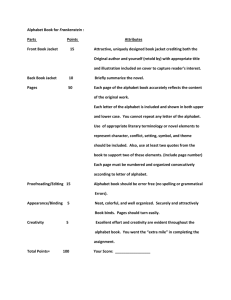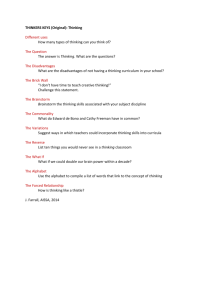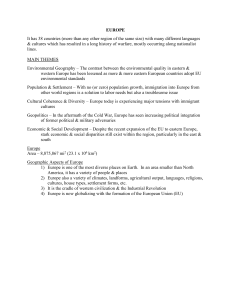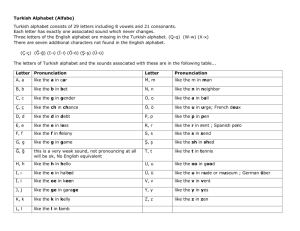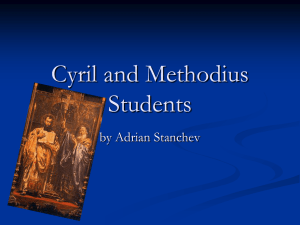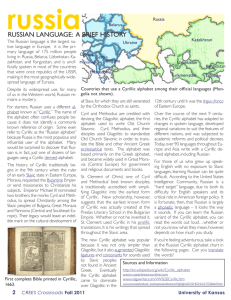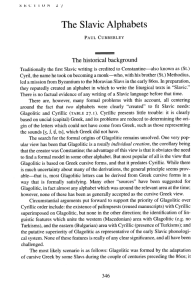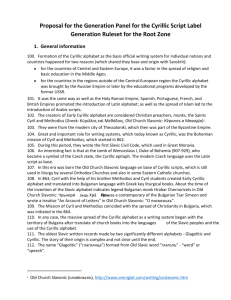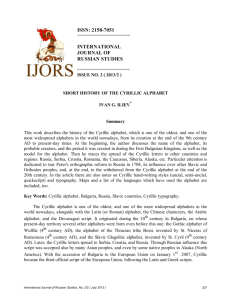File
advertisement
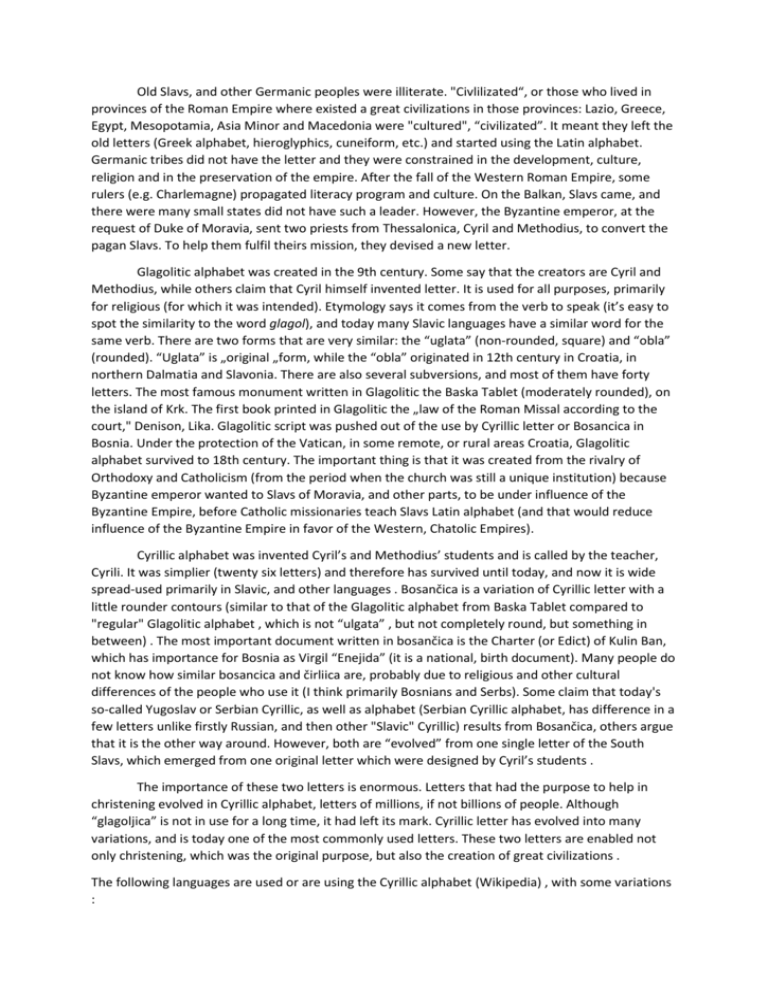
Old Slavs, and other Germanic peoples were illiterate. "Civlilizated“, or those who lived in provinces of the Roman Empire where existed a great civilizations in those provinces: Lazio, Greece, Egypt, Mesopotamia, Asia Minor and Macedonia were "cultured", “civilizated”. It meant they left the old letters (Greek alphabet, hieroglyphics, cuneiform, etc.) and started using the Latin alphabet. Germanic tribes did not have the letter and they were constrained in the development, culture, religion and in the preservation of the empire. After the fall of the Western Roman Empire, some rulers (e.g. Charlemagne) propagated literacy program and culture. On the Balkan, Slavs came, and there were many small states did not have such a leader. However, the Byzantine emperor, at the request of Duke of Moravia, sent two priests from Thessalonica, Cyril and Methodius, to convert the pagan Slavs. To help them fulfil theirs mission, they devised a new letter. Glagolitic alphabet was created in the 9th century. Some say that the creators are Cyril and Methodius, while others claim that Cyril himself invented letter. It is used for all purposes, primarily for religious (for which it was intended). Etymology says it comes from the verb to speak (it’s easy to spot the similarity to the word glagol), and today many Slavic languages have a similar word for the same verb. There are two forms that are very similar: the “uglata” (non-rounded, square) and “obla” (rounded). “Uglata” is „original „form, while the “obla” originated in 12th century in Croatia, in northern Dalmatia and Slavonia. There are also several subversions, and most of them have forty letters. The most famous monument written in Glagolitic the Baska Tablet (moderately rounded), on the island of Krk. The first book printed in Glagolitic the „law of the Roman Missal according to the court," Denison, Lika. Glagolitic script was pushed out of the use by Cyrillic letter or Bosancica in Bosnia. Under the protection of the Vatican, in some remote, or rural areas Croatia, Glagolitic alphabet survived to 18th century. The important thing is that it was created from the rivalry of Orthodoxy and Catholicism (from the period when the church was still a unique institution) because Byzantine emperor wanted to Slavs of Moravia, and other parts, to be under influence of the Byzantine Empire, before Catholic missionaries teach Slavs Latin alphabet (and that would reduce influence of the Byzantine Empire in favor of the Western, Chatolic Empires). Cyrillic alphabet was invented Cyril’s and Methodius’ students and is called by the teacher, Cyrili. It was simplier (twenty six letters) and therefore has survived until today, and now it is wide spread-used primarily in Slavic, and other languages . Bosančica is a variation of Cyrillic letter with a little rounder contours (similar to that of the Glagolitic alphabet from Baska Tablet compared to "regular" Glagolitic alphabet , which is not “ulgata” , but not completely round, but something in between) . The most important document written in bosančica is the Charter (or Edict) of Kulin Ban, which has importance for Bosnia as Virgil “Enejida” (it is a national, birth document). Many people do not know how similar bosancica and čirliica are, probably due to religious and other cultural differences of the people who use it (I think primarily Bosnians and Serbs). Some claim that today's so-called Yugoslav or Serbian Cyrillic, as well as alphabet (Serbian Cyrillic alphabet, has difference in a few letters unlike firstly Russian, and then other "Slavic" Cyrillic) results from Bosančica, others argue that it is the other way around. However, both are “evolved” from one single letter of the South Slavs, which emerged from one original letter which were designed by Cyril’s students . The importance of these two letters is enormous. Letters that had the purpose to help in christening evolved in Cyrillic alphabet, letters of millions, if not billions of people. Although “glagoljica” is not in use for a long time, it had left its mark. Cyrillic letter has evolved into many variations, and is today one of the most commonly used letters. These two letters are enabled not only christening, which was the original purpose, but also the creation of great civilizations . The following languages are used or are using the Cyrillic alphabet (Wikipedia) , with some variations : • Indo-European Languages • Slavic Languages • Russian • Ukrainian • Belarussian • Serbian ( Cyrillic equal footing with that used the Latin alphabet) • Bosnia ( who along with Cyrillic and Latin alphabet used equally ) • Croatian (also with Cyrillic and Latin alphabet used equally ) • Macedonian • Bulgaria • Indo - Iranian languages • Ossetian • Tajik • Romance • Romanian ( until the 19th century , and Moldavia between 1940 and 1989 (see Moldavian ) ) • other Indo-European languages • Roma ( in Bosnia and Serbia and the countries of the former USSR ) • Kurdish ( with Kurds who live in the countries of the former Soviet Union ) • Altaic languages • Turkic languages • Azer (1939-1991) • Tatar • Turkmen (1940-1994) • Uzbek (1940-1998) • Kirghiz • Kazakh and “ganguški” ( 1957 ) • Finno Ugric languages • Udmurt • “kildinski” “saamijski” • Erzya • other , mainly Altaic languages • “abaski” • Abkhazian • “adidžeji” • “ajsorski” • Altaic • “Avar” • “Balkar” • Bashkir • Buryat • Chechen (1940-1991) • Chuvash • “čukčijski” • “dargvaski” • “dunganski” • “evenkski” • “kabardijanski” • Kalmyk • “karačejski” • “karakalpački” • Karelian • “kakaski” • “kantski” • “Komi” • “korjački” • “kumički” • “Lacko” • “lezgijanski” • “mansijanski” • Mari • Mongolian • “nanajski” • NenetsThe • Nogai • “orijatski” • Selkup • “tabasaranski” • Hallstatt • Tuvan • “udekanski” (udeganski) and Yakut languages ) • Artificial languages • reputed (who equally used with Cyrillic and Latin alphabet) • New linguae franca.



